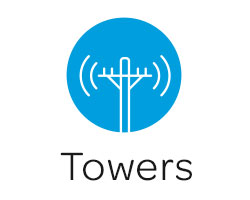If this page does not automatically redirect, click here.
Latest News
First in the U.S. to Mobile 5G – What’s Next? Defining AT&T’s Network Path in 2019 and Beyond
January 9, 2019
AT&T is the first U.S. carrier to introduce a standards-based, mobile 5G network and device. We’re the tip of the spear, driving the 3GPP standards body and leading the world on how 5G will be deployed. Read more.
AT&T to Bring Standards Based 5G to AT&T Stadium
January 8, 2019
AT&T became the first to introduce standards-based mobile 5G services a few weeks ago. And now, we’re announcing plans to be the first U.S. carrier to light up 5G at one of the most iconic venues in the country – AT&T Stadium in Arlington, Texas. Read more.
AT&T and Rush System for Health Ink Agreement to Use 5G in Hospital Setting
January 8, 2019
AT&T and Chicago-based Rush University Medical Center and the Rush System for Health are working to bring the first standards-based 5G enabled hospital to the U.S. Read more.
We’re Making the Best Network Even Better with 5G Evolution in 400+ Markets by Year End
December 20, 2018
This year we were named the Nation’s Best Network according to America’s biggest test,1 but we aren’t stopping there. The best network is even better with the 5G Evolution technologies available in 385 markets today, with plans to reach 400 markets in the coming days. Learn more.
AT&T First to Make Mobile 5G Service Live in the U.S. on Dec. 21
December 18, 2018
On Dec. 21, AT&T will be the first and only company in the U.S. to offer a mobile 5G device over a commercial, standards-based mobile 5G network. Read more.
AT&T to Add Second Samsung Smartphone to Mobile 5G Portfolio in 2019
December 5, 2018
We’re pleased to announce we’re working with Samsung to bring another standards-based 5G device to AT&T customers in 2019. This smartphone from Samsung will be able to access both 5G mmWave and sub-6 GHz. We expect to offer this device in the second half of 2019. Read more.
AT&T to Offer More Mobile 5G Devices
December 4, 2018
AT&T announced plans to grow its mobile 5G device lineup with a 5G smartphone from Samsung in the first half of 2019. This 5G smartphone will give customers on a compatible plan access to the 5G network we plan to introduce before the end of 2018. This is the second mobile 5G device we have announced. Read more.
Future of 5G Technology

5G’s Promise
Much like 4G introduced the world to the gig economy, we believe mobile 5G will jumpstart the next wave of unforeseen innovation. AT&T is the only U.S. carrier that has announced plans to start deploying a standards-based, mobile 5G network in parts of a dozen cities by the end of 2018 – Atlanta, Charlotte, Dallas, Houston, Indianapolis, Jacksonville, Louisville, New Orleans, Oklahoma City, Raleigh, San Antonio and Waco.
Looking forward to early 2019, we’ll keep our 5G momentum going and plan to introduce mobile 5G in parts of Las Vegas, Los Angeles, Nashville, Orlando, San Diego, San Francisco, and San Jose. From these 19 cities, we’ll continue to expand.
5G will ultimately unlock use cases that are dependent on faster speed, wide coverage, and low latency. Think of this as the next frontier in untethering, giving you the ability to take the ultra-fast experience you have in your home or business with you virtually anywhere. This next revolution in wireless technology will create significant new economic opportunities and better experiences for people and businesses serving customers across industries as well as creating new ones.
Our trial with Magnolia Silos in Waco, Texas provided us a glimpse into how 5G could change retail for example. We observed wireless speeds of approximately 1.2 Gbps in a 400 MHz channel and RAN latency rates at 9-12 milliseconds.
Whether you’re a retailer, car wash owner, hospital, manufacturer, public safety entity or a bank, 5G promises to change the customer experience and provide new economic opportunities for your business.
For information and statements related to 5G regulatory matters, please visit AT&T’s Public Policy forum.
Connectivity Impact of Future Technologies and Services
Data traffic on AT&T’s mobile network has grown more than 360,000% since 2007. Video traffic increased over 75% in the last year and continues to be the largest driver of this growth, making up more than half of our mobile data traffic.

For new technologies to be widely deployed, mobile networks will need to deliver complex and wide ranging network management capabilities for quality, performance, bandwidth, latency, and coverage. For example, for the self-driving car experiences to meet future customer expectations, it will be critical to quickly communicate with other connected vehicles and objects with high reliability while the vehicle is in motion.
Investing in America
Between 2014 and 2018, AT&T invested more in the U.S. than any other public company — more than $130 billion including capital investment and acquisitions of spectrum and wireless operations. Our wireless network now covers more than 99% of Americans, our fiber network is one of the nation’s largest and we connect more Internet of Things devices than any other provider in North America. Additionally, more than 3 million businesses, from the largest global companies to small businesses, turn to AT&T.
Our Mobile 5G Foundation
By investing in our wireless network today we’re bringing faster speeds now, and will upgrade to mobile 5G when it’s ready.
We’re building our mobile 5G network on top of the best network in the United States. We recently won top accolade of the best network according to America’s biggest test. Further details can be found here: www.gwsolutions.com/bestnetwork-USA.
In 239 markets we’ve laid the mobile 5G network foundation with 5G Evolution technologies, and we are planning to reach 400+ markets by end of 2018. In the first half of 2019, we plan to offer nationwide coverage, making 5G Evolution available to over 200 million people. We’ve also extended availability of our LTE-LAA technology to now offer a better wireless experience in parts of 20 cities, coming to at least 24 cities this year.
For more on how these technologies support our mobile 5G vision, please read “Setting the Record Straight on 5G Evolution.” And if you want to learn where 5G Evolution and LTE-LAA technologies are available, how fast these technologies can make our network, and a list of capable devices, please read this blog.
Key Areas

The success of mobile 5G relies on a quality fiber connection to the wireless towers or small cells, which then translate the fiber connection into an ultra-fast wireless signal for customers. By putting fiber at the core of our wired and wireless networks, we’ve been laying the foundation for our 5G wireless connectivity.
We have millions of miles of fiber. We also have the largest fiber network across the 21 states where we offer home internet service, offering ultra-fast internet powered by AT&T Fiber to more than 10 million locations. By mid-2019, we plan to reach at least 14 million locations. For more on AT&T Fiber, go to att.com/getfiber.

By placing small cells on streetlights, utility poles and other structures we’re bringing faster speeds closer to more customers. We are deploying thousands of small cells, which lays the groundwork for future technologies such as 5G.
We also expect small cell technology to help fortify the FirstNet public safety communications network by adding more capacity for first responders where it’s needed most. This, coupled with 5G technology and Smart Cities solutions, plus existing AT&T Fiber ultra-fast Internet service, will help create a safer, more efficient, and sustainable community.

By working with more suppliers and tower companies, we’re overhauling the cost and layers associated with the traditional wireless tower model. This makes it possible for us to stay ahead of the growth in mobile data usage, giving customers access to faster speeds and a better wireless experience in more locations.
5G will be our first major new technology that will be “born in the cloud” and the experience we’ve gained by leading the industry transformation to virtualization and software control will be invaluable to helping us move quickly and efficiently. 5G will ultimately enable ultra-low latency and massive machine-to-machine communications, which will be distributed in nature, and our software-defined network (SDN) control expertise will allow us to control the data flow through software. For more details on how vital software will be for a mobile 5G world read our CTO’s “software + 5G = a perfect match” blog.
Security is embedded in the network as we migrate to 5G. This enhances our security posture to prevent, detect and mitigate threats to the mobile network and devices. As a software-defined network (SDN) pioneer and innovator, our work to counter cyber threats is instrumental in shaping the 5G security standards and ecosystems. We’re working with 3GPP to create a stronger encryption algorithm for a 5G, over-the-air interface. We are also developing recommendations for the FCC’s Communications Security, Reliability and Interoperability Council (“CSRIC”).
Since early 2016, we’ve been one of the top North American wireless carrier contributing to 3GPP’s work on 5G standards. This includes the ability of 5G to co-exist on the same spectrum as LTE, an energy- and battery-efficient physical layer and a framework for massive MIMO. We’ve made multiple material contributions to standards for all radio access network layers. This includes the physical, protocol and systems architecture layers, as well as the system requirements, architecture, security and performance aspects of 5G. For more on how standards impact our mobile 5G approach, read this blog by AT&T’s CTO. https://about.att.com/innovationblog/5g_software_standard
We’re a leader in the adoption of edge computing to bring a seamless and instant interaction to new connected applications like self-driving cars, augmented and virtual reality (AR/VR) and robotic manufacturing where even a few extra milliseconds can mean the difference. We’re bringing the network closer to users by moving using cloud computation. Rather than travel over wireless connections to data centers hundreds or thousands of miles away, we’ll propel this data across super-responsive 5G networks to computers just a few miles away. To learn more about AT&T’s edge computing commitment, further details can be found here. https://about.att.com/story/2018/edge_update.html
In the U.S., AT&T’s current holdings total 145 MHz of sub-3GHz spectrum, plus access to 20MHz held by FirstNet. Winning the FirstNet award gives AT&T access to a nationwide 20MHz block of 700 MHz spectrum to construct the Nationwide Public Safety Broadband Network (NPSBN). While that spectrum will naturally fulfill the needs of public safety users first, any unused FirstNet spectrum may be used to meet AT&T customer needs.
AT&T low-band holdings consist of 700 MHz (BC and DE) and Cellular (850 MHz). AT&T mid-band holdings are Personal Communications Service (PCS) in the 1900 MHz range and Advanced Wireless Services (AWS) in the 1700 MHz (uplink) and 2100 MHz (downlink) ranges. AT&T high-band includes Wireless Communication Services (WCS) in the 2300 MHz range. Further, AT&T owns spectrum in Mexico, 202 MHz, approximately 33% share of the total Mexican nationwide spectrum.
How Business Will Benefit

AT&T and Samsung Create America’s First Manufacturing-focused 5G “Innovation Zone”
AT&T Brings Connectivity and Content to Magic Leap to Create the Future of Entertainment
5G and the Future Business Experience
AT&T Launches 5G Trial with Magnolia at the Silos
Check out att.com/5Gforbiz if want to go a layer deeper on 5G’s promise for businesses.
Giving Consumers an Edge

AT&T Continues to Lead in Bringing 5G Experiences to Life
AT&T Names 99 New 5G Evolution Markets
Edge Computing and 5G: Unlocking the Future of Gaming
Frisco Station and AT&T to Create 5G Evolution Connected Community from the Ground Up
Inside the AT&T Foundry: Connectivity and Autonomous Vehicles
AT&T Drives Path to Nationwide Mobile 5G With Multi-Gigabit Speeds

